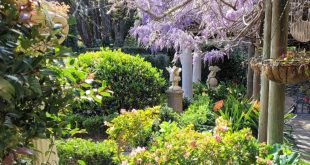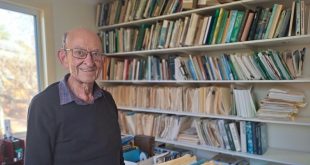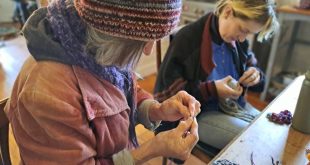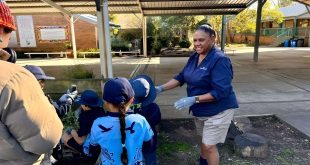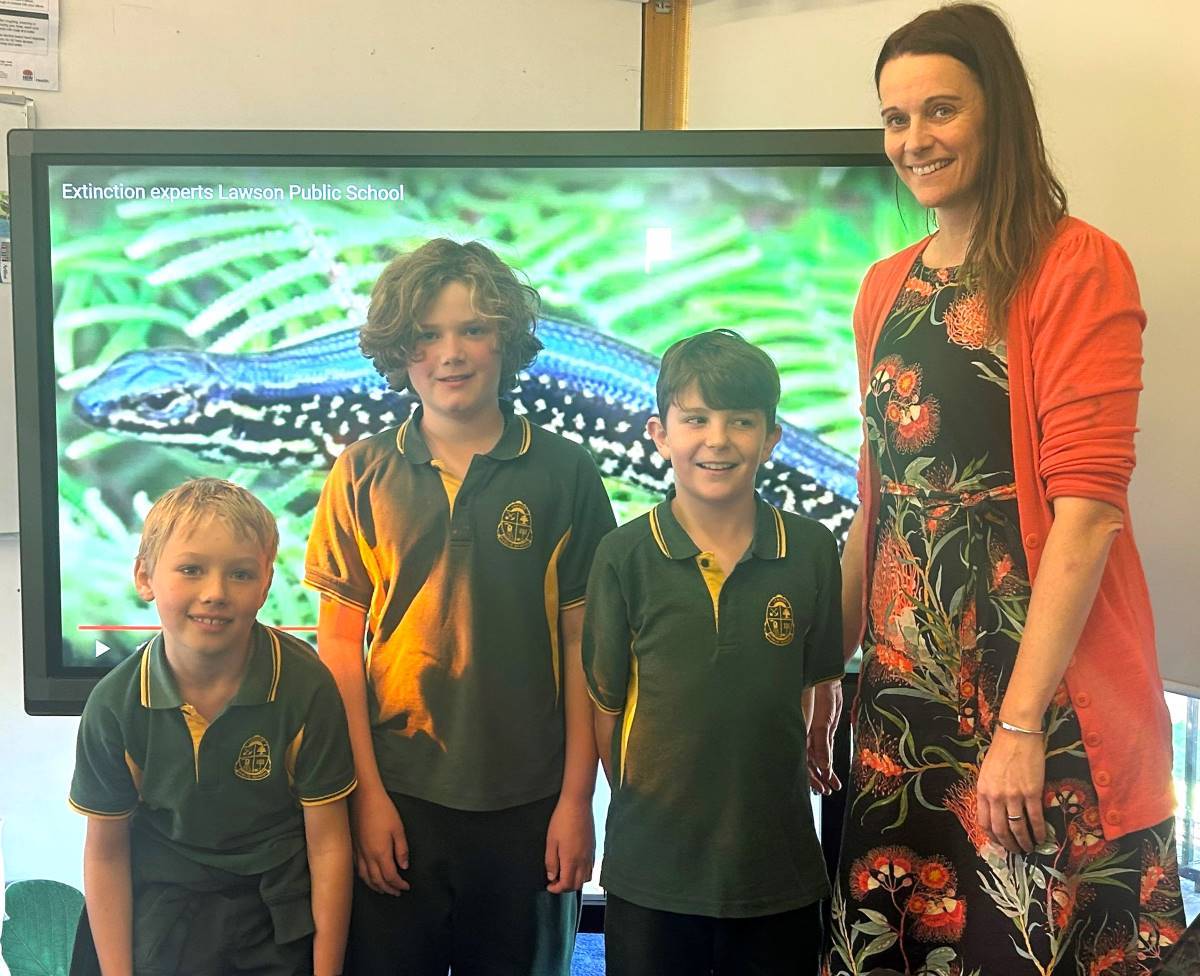
‘Extinction Experts’: Oliver, Leo and Timothy with teacher Jane Truswell (not pictured: Archer and Wren)
Story by Liz Durnan
When school kids around the state heard the call: Invent or innovate something that will change our world and leave a lasting impact, Lawson Public School students rose to the challenge.
The day I visit Lawson Public School, the children gathered in the library are buzzing with excitement. They’re fresh from taking part in this year’s Game Changer Challenge, with two of the three teams making it to the semi-finals.
Key Points:
- The Game Changer Challenge is an annual event by the NSW Department of Education
- In 2023 students were challenged to ‘invent or innovate something that will change our world and leave a lasting impact’
- Lawson Public School took up the challenge in 2023 with impressive results
In the annual Game Changer Challenge, the NSW Department of Education sets a ‘Wicked Problem’ for primary and secondary schools around the state. This ‘design thinking competition’ encourages students to discover real-world solutions to real-world problems.
The three teams have devised their own names – Einstein’s Minions (years 5 & 6) are addressing the issue of bushfires; The Extinction Experts (years 3 & 4) look at species loss in the Blue Mountains; and The Revolution Ducks (years 4, 5 & 6) tackle the problem of littering.
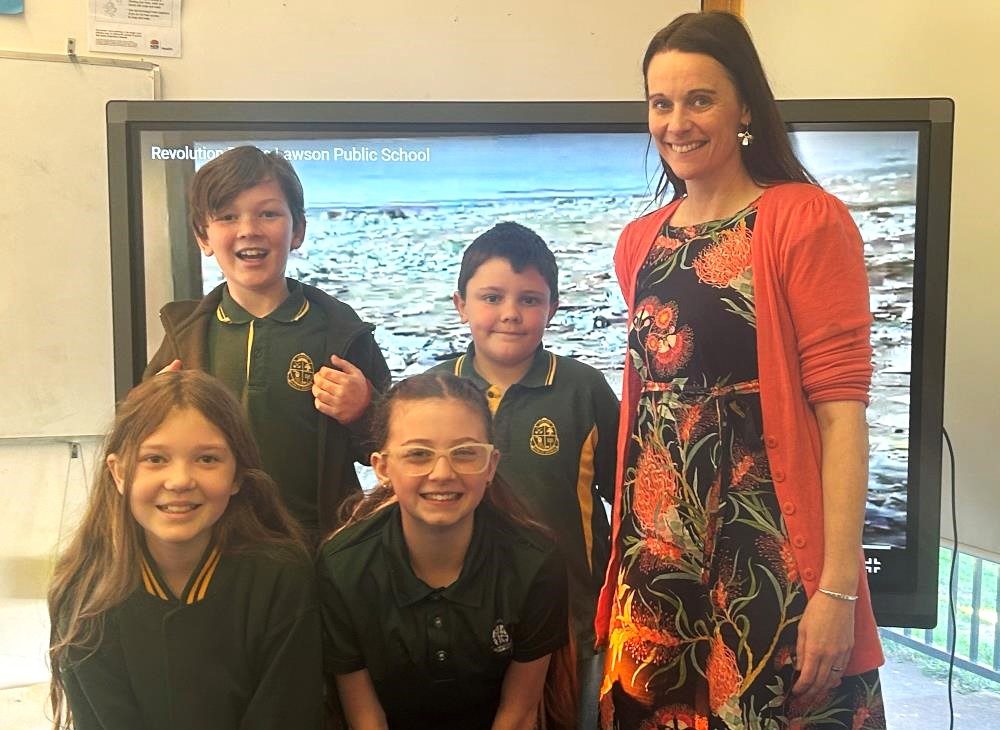
Team ‘Revolution Ducks’: Devendra, Lachlan, Talara and Luella with teacher Jane Truswell (not pictured: Sadie)
According to Learning & Support Teacher Jane Truswell, the Game Changer Challenge inspires the students to think carefully about practical ways they can make an impact.
“It has given them a sense of agency to face the world’s problems,” Jane says. “If they want to talk to somebody in the field, they can interview an ecologist or they can talk to people from different services and find out more.
This is not something they’ve done before, so it’s really helped connect their learning with things they can change in the world. – Jane Truswell, Learning & Support Teacher
Relieving Principal Hayley Cross agrees: “Because the students went out to survey people for their research, the Challenge provided amazing learning opportunities. They were able to tap into a whole other world of learning that allows this out-of-the-box thinking.”
Once each group identified a problem to tackle, they invented their solution and designed a prototype. According to Jane, this design process helped students engage with the reality of the problem.
Each group then filmed a two-minute video outlining the solution and the process.
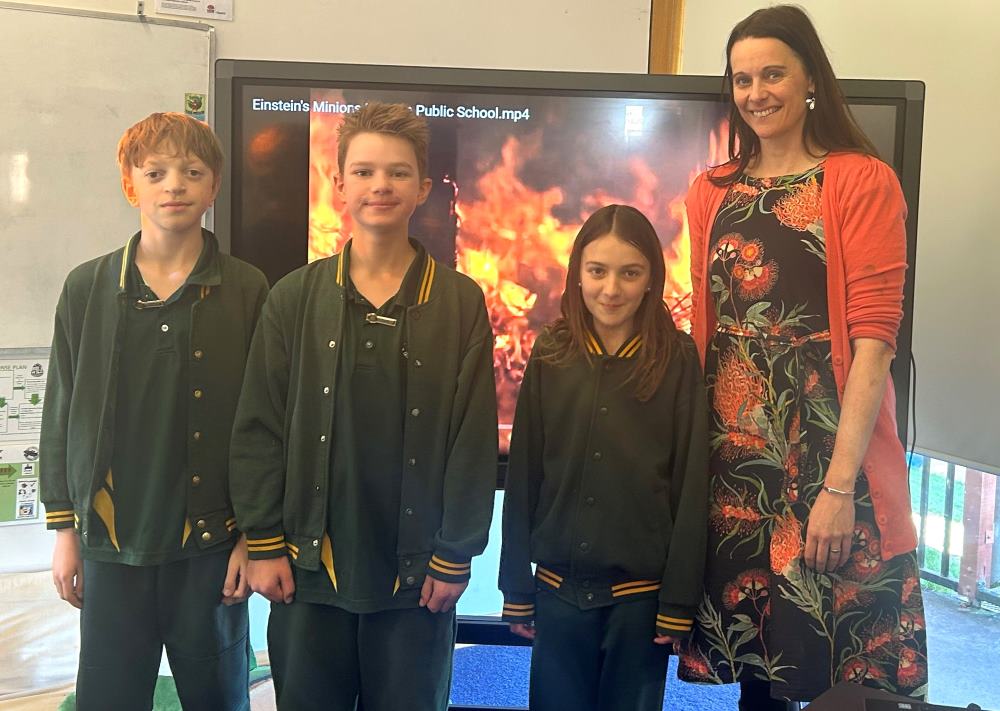
Team ‘Einstein’s Minions’: Harry, Rhys and Seren ( Not pictured: Alby and Mytchell)
I watch these videos with genuine interest, impressed at the innovative ideas conceived by these students. They are only between 8 and 11 years of age.
Team Extinction Experts
The Extinction Experts looked at animals that are vulnerable to extinction, and focused specifically on threats faced by local species such as the Blue Mountains Water Skink and the Eastern Pygmy Possum.
After finding out more about these creatures, the group proposed an invention they called ‘the hideaway tube’ – a weatherproof retreat space the animal could hide in to cope with extreme events.
As part of their research, the students spoke to Julie Favell from the Lithgow Environment Group, learning about post-bushfire research on homes for Pygmy Possums and how people have reused pipes to create homes for the animals.
Team Revolution Ducks
Meanwhile, The Revolution Ducks focused on the impact of littering, examining rubbish sorting and waste minimisation initiatives at Lawson.

The Revolution Ducks team work on their video submission
Their idea was to make this waste more sortable with the invention of a wearable backpack designed specifically for waste: complete with sections for people to sort their waste on the go.
Team Einstein’s Minions
The third team, Einstein’s Minions, investigated bushfires and conceived a complex solution involving temperature sensors and sprinklers that would react to temperatures, cooling down surfaces in the event of bushfire. For this, they extensively researched backburning and the ways it’s used to fight bushfires.
In each case, the problem focuses on an issue that directly affects their local community. The students surveyed their peers extensively, then their wider community, to discover the things that impact them, and what they worry about.
They also found their solutions within that community, mostly from experts with local knowledge.
It’s even more impressive to learn that the children came up with many of the ideas independently, with only a little help and encouragement from Jane.
Design Thinking
Along with playbooks provided by the Department of Education to teach design thinking strategies, the teams worked together to use research to find solutions.
For anyone wondering what ‘design thinking’ means, the Department of Education’s Game Changer website explains:
- Design thinking is a human-centred process to solving complex problems.
- Empathy and collaboration are at the heart of design thinking.
- The five-step process starts by encouraging problem solvers to walk in the shoes of those experiencing the ‘problem’ to gain a deeper insight into the challenges and issues they face (empathy).
- This knowledge is then used to develop a clear problem statement (define), work on solutions (ideate), turn these solutions into tangible products (prototype) and then see whether the solution will work (test).
When I talk to the students about their ideas, their enthusiasm is palpable. I hear how they’re directly affected by the issues they address, such as bushfires, and how closely some have been personally impacted by them.
“We had loads of ideas actually,” Harry from Einstein’s Minions tells me. “And I don’t know how we decided on bushfires. It’s something you think about quite a bit.”
While they all agree the project was ‘lots of fun’, they’re candid about the difficulties at times. They articulated one of the most important life lessons: you make mistakes, fail and repeat the process until you get it.
Making the video was another key learning experience, also completed with minimal help from teachers who mainly provided guidance on using the technology and script storyboarding.
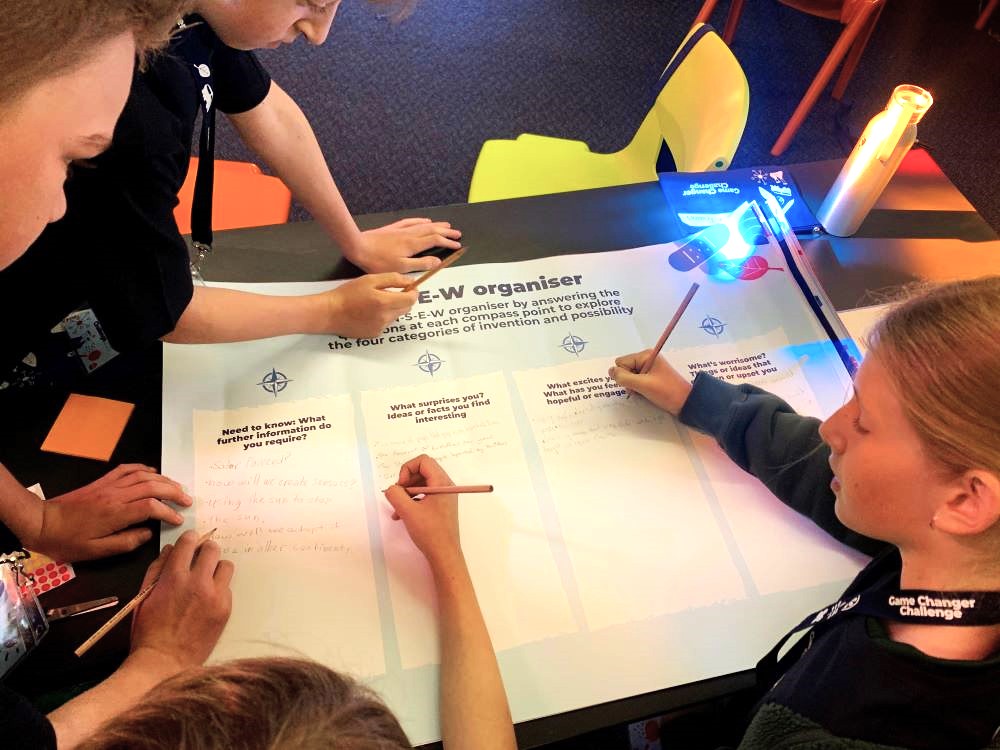
The Einstein’s Minion’s team participate in a semi-final brainstorming session.
This all fostered a collaborative supportive approach among the children with the teams helping each other out despite them being up against each other in the competition.
According to Hayley, the roles each student took on within the group enhanced not only the learning process, but also their social skills.
“They had to work as a team, even though many of the academically bright kids can be very solo,” Hayley says.
“This was challenging at first because they had to look at their skills: some might be communicators; some might have emerging leadership skills. They didn’t always get the role they wanted but they took it maturely and worked together.
“And they completed the project, which doesn’t always happen because they’re interested in lots of new things. But here, we had a deadline to stick to, so it really allowed us to do that full circle.”
She is equally proud of all the teams and embraced the idea of the Game Changer Challenge when presented by Jane.
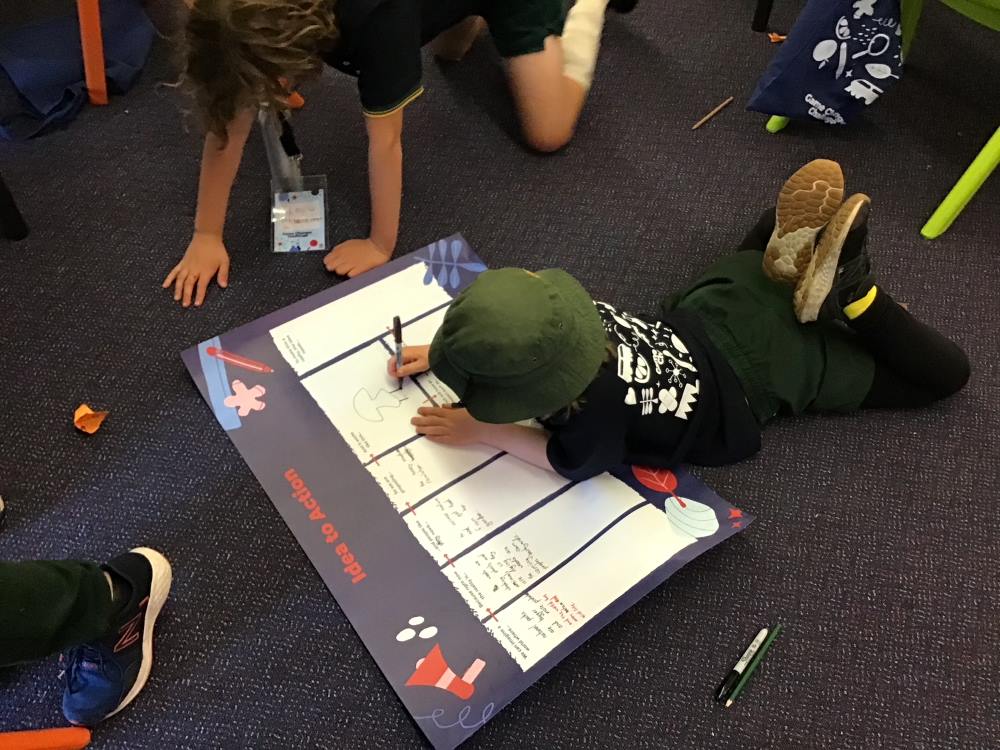
The Extinction Experts team work on large design canvases during the semi final
For Jane, discovering solutions empowered the students to make sense of the world.
The Game Changer Challenge is very much around listening to what kids would like and how they’d like to make the world a better place. – Jane Truswell
Hayley agrees. “Sometimes people say, ‘Oh, you’re just kids’. But kids make a huge difference. And it starts there, doesn’t it?”
120 teams took part in the virtual semi-finals of the Game Changer Challenge, held in Week Six and Seven of Term Three.
Take Action:
- To involve your school in 2024 visit https://education.nsw.gov.au/public-schools/game-changer-challenge
- Learn about design thinking in NSW schools: https://education.nsw.gov.au/public-schools/game-changer-challenge/teacher-information
- Share this story with students and teachers in your community to help more schools take up the challenge!
Share this article:
This story has been produced as part of a Bioregional Collaboration for Planetary Health and is supported by the Disaster Risk Reduction Fund (DRRF). The DRRF is jointly funded by the Australian and New South Wales governments.
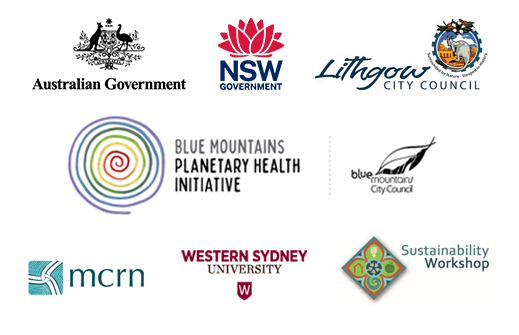
More from around the region
As 190 countries gather for the @cop16colombia UN Biodiversity Summit, to focus on how we can protect the world’s flora and fauna, we’d like to thank all those local individuals and organisations dedicated to the same goal who came together for World Animal Day at the Blue Mountains Planetary Health Centre on Saturday 5 October. They offered ways for everyone to learn more and take action. From the Blue Mountains Bird Observers, who led over 40 people on a guided Breakfast with the Birds walk, to many others who offered information stalls, talks, workshops, a Wild Life exhibition, live music, plant-based food and hands-on Bushcare. We also launched the Community Plant Based Cooking Project with the first class to be held on Saturday 9 November at @roseyravelstonbooks in Lawson. Places are limited. Learn more here: https://plantinspired.com.au/
#worldanimalday #biodiversity #plantbased #planetaryhealth #bluemountains #katoomba
Did you know that old lino, window putty, and adhesive can contain asbestos? Yesterday the Asbestos & Hazardous Materials Management Conference kicked off with a pre-conference workshop at the Blue Mountains Planetary Health Centre. It included hands-on `spot the asbestos` and asbestos sampling sessions. This year`s theme is `Working together for a safe and healthy future`. #asbestos #hazardousmaterials #conference #planetaryhealth #bluemountains #katoomba
A huge thank you to Josh Logan from Logan Signs, Lithgow, for installing our Circular Water Signage in time for our World Animal Day Celebration today at the Blue Mountains Planetary Health Centre (33-39 Acacia St Katoomba). We have a full program of events with lots of information on how to prepare for the summer ahead and how to create urban areas that help us share our home respectfully with all species. It will be a fun family day too with storytime, craft and live music for kids! (Link in profile) #worldanimalday #planetaryhealth #familyday #katoomba #bluemountains
And our Wild Life exhibition is now up for World Animal Day tomorrow at the Blue Mountains Planetary Health Centre. Photographs by Warren Hinder, Merryl Watkins, Holly Kent and Tracy Burgess. Check out all the other events from stalls, talks, possum box demo, kid`s craft and animal storytime, plant based food and live music to Bushcare. @33-39 Acacia St Katoomba Link in profile. #planetaryhealth #worldanimalday #katoomba
Join the Blue Mountains Planetary Health Initiative at World Animal Day this Saturday 5 October for a discussion on the history of the Plant Based Food Movement in Australia and a discussion of exciting contemporary trends. It will be followed by a Plant Based Cheese Degustation to launch the Plant Inspired Community Cooking Project. This will be a series of cooking classes to introduce the community to plant based cooking techniques. The event is free but places are limited so bookings essential (link in profile): https://bit.ly/3Bzbwhu
#plantbasedcooking #worldanimalday #bluemountains #katoomba #planetaryhealth #communitycooking
We share the Blue Mountains with so many extraordinary beings but have you seen them and do you know their names? Do you know the difference between a Royal Spoonbill and an Eastern Shrike-tit, or the difference between a bandicoot and an antechinus? Come and check out our Wild Life Exhibition at World Animal Day this Saturday to learn more from the stunning photographs by Warren Hinder, Merryl Watkins, Holly Kent and Tracy Burgess. There will be also be a Breakfast with the Birds at 8.30am, Animal Storytime and Craft for kids from 10am, stalls, talks, food and live music. The day is free but please book via Eventbrite to help us cater (link in profile): https://bit.ly/4eMhbz0 @bluemountainswalks @merrylwatkinsphotography @bestofbluemountains
#royalspoonbill #easternshriketit #wildlife #birdsofthebluemountains #bluemountains #katoomba #worldanimalday #biodiversity #planetaryhealth
To coincide with the first day of Bushfire Season we launched Air Watch at the Planetary Health Centre yesterday. For the last seven years Blue Mountains Unions & Community have been working tirelessly to ensure residents of the Blue Mountains and Lithgow are able to measure and track the quality of the air we breathe. The Blue Mountains Planetary Health Initiative has worked closely with them over the last year and now there are 20 PurpleAir monitors distributed throughout the Blue Mountains and Lithgow, including one at the Planetary Health Centre. You can now view real time air quality measurements at each of our local news sites and on the Purple Air Map https://map.purpleair.com We have 10 more sensors available, so if you’d like to install a sensor, members of BMUC will be at World Animal Day at the Planetary Health Centre this Saturday 5 October to take applications and share more information about the project. Bookings for World Animal Day here (link in profile): https://www.eventbrite.com.au/e/world-animal-day-promoting-respectful-cohabitation-tickets-1029328889417
It was a fabulous day yesterday as each speaker highlighted how critically important this project is: Dr Rosemary Dillon CEO of Blue Mountains City Council Trish Doyle MP Dr Jenna Condie from Blue Mountains Parents for Climate Dr Maggie Davidson, environmental scientist from Western Sydney University Matthew Riley, Director Climate and Atmospheric Science from NSW Department of Climate Change, Energy, the Environment and Water and Peter Lammiman and Ann-Maree McEwan from the BMUC’s Airwatch Committee.
@bluemountainsunionists @nswdcceew @bluemountainscitycouncil @westernsydneyu @trishdoylemp @parentsforclimatebluemountains #airqualilty #airqualitymonitors #bluemountains #planetaryhealth
Treat yourself this weekend with a fun-filled and informative World Animal Day event at the Planetary Health Precinct in Katoomba. As well as a Breakfast with the Birds, stalls and a possum box demonstration, there will be a fabulous wildlife exhibition with photos by Warren Hinder, Merryl Watkins, Tracy Burgess and Holly Jayne; live music with Mem Davis, Joe Flood and Duck Keegan; lots of fun for kids with Sharon Baldwin and Naomi Crew leading animal storytime and craft with Julie Refferty; delicious plant based, gluten and dairy free treats, pastries and donuts from Clean Cravings; a plant based cheese degustation and warming Dahl, rice roasted cauliflower with veggies, pakoras, tamarind chutney, and salad courtesy of Bibi’s Kitchen. Come and learn more about Blue Mountains Bird Observers, Blue Mountains Conservation Society, WIRES, Action for Animals Blue Mountains and Animal Sanctuaries, Wombat Rescue, the Women’s Shed, and Animal Welfare Laws in Australia.
Guest speakers throughout the day will include Elizabeth Ellis, lecturer and author of Australian Animal Law; Hal Ginges, a local lawyer and animal activist from Action for Animals who advocates for animal rights and raises money for sanctuaries; Mark Berriman who has been President of the Australian Vegetarian Society NSW since 1989, as well as Co-ordinator for Animal Liberation NSW, Director of the Natural Health Society of Australia and the World League for Protection of Animals; and Teya Brooks Pribac, a researcher in the area of animal studies and the award-winning author of Enter the Animal. She’s also published Not Just Another Vegan Cookbook and will be sharing her culinary skills with the community in the Plant Inspired Community Cooking Project.
The event is free but please book your place to help us cater (link in profile): https://www.eventbrite.com.au/e/world-animal-day-promoting-respectful-cohabitation-tickets-1029328889417
#worldanimalday #plantbased #planetaryhealth #katoomba #bluemountains
We are so looking forward to kicking off World Animal Day Celebrations on Saturday 5 October with an 8.30am Breakfast with the Birds. Join Paul Nagle from the Blue Mountains Bird Observers on a guided bird walk around the Planetary Health Precinct visiting different habitats on the site to observe and talk about the birdlife that is resident and that visits the site. Binoculars are highly recommended.
World Animal Day will be an inspiring family day celebrating the extraordinary diversity of animals we share our world with! The theme is `Promoting Respectful Cohabitation`. Bookings for the Breakfast with the Birds (link in profile)
or here:
https://www.eventbrite.com.au/e/breakfast-with-the-birds-tickets-1028664983657
#birdlife #breakfastwiththebirds #katoomba #worldanimalday #bluemountains #planetaryhealth #respectfulcohabitation
We all need clean air to breathe, but how can we tell how clean our air is?
Thankfully the Air Watch subcommittee of Blue Mountains Unions & Community has worked for years to find ways to help us measure the quality of the air we breathe. Over the past year the Blue Mountains Planetary Health Initiative has worked with them to install Purple Air Quality monitors across our bioregion from Lithgow to the Lower Mountains. You can now view real time air quality on each of our Local News Sites!
Air Watch`s Purple Air quality monitors give the Blue Mountains` 78,000 residents, workers and 3 to 5 million/year visitors the power to make timely, informed decisions about their activities and health. It will also be a reliable source of data for the scientific community.
To coincide with the start of the Bushfire Season on Tuesday 1 October, we`re inviting the whole community to join us to launch Air Watch Blue Mountains and Lithgow at the Planetary Health Precinct. If you`d like to join us book a place here https://bit.ly/4dp2qko (link in profile)
#airquality #purpleair #bluemountainsunionscouncil #planetaryhealth #bluemountains #katoomba #bushfireseason


